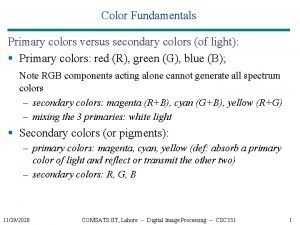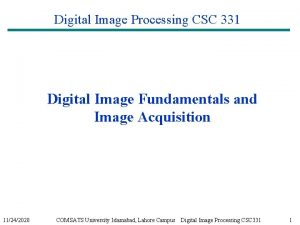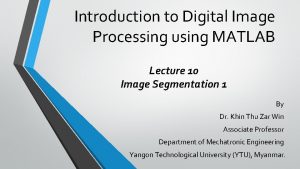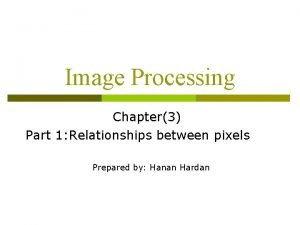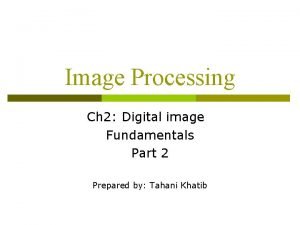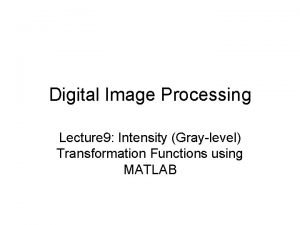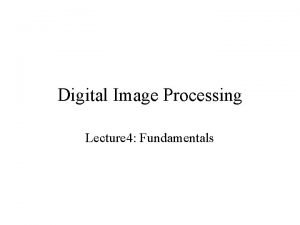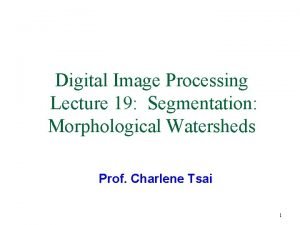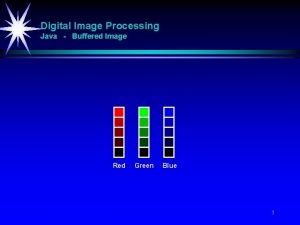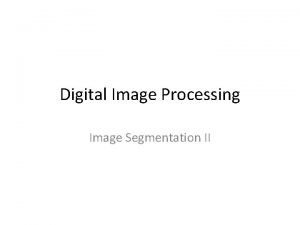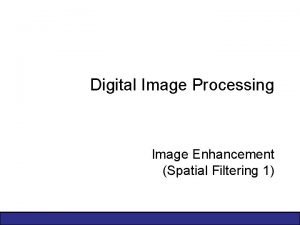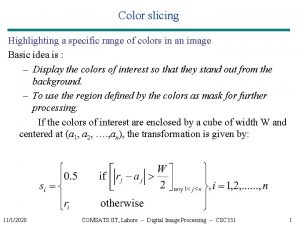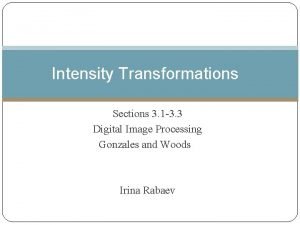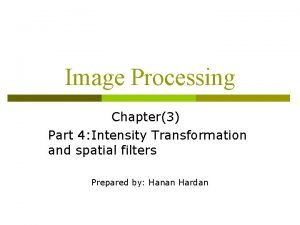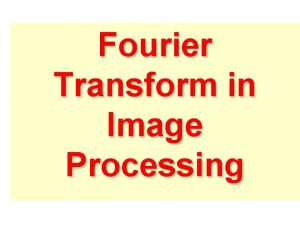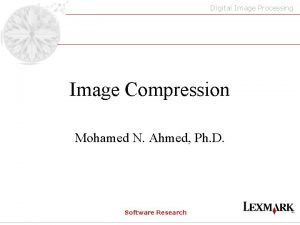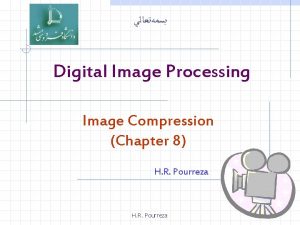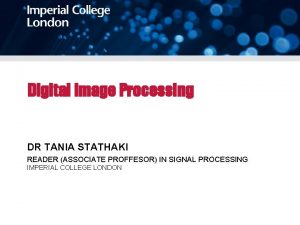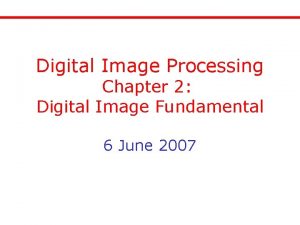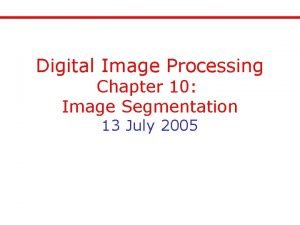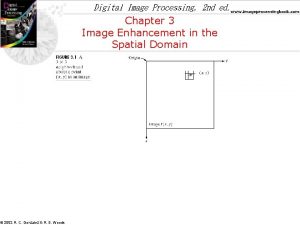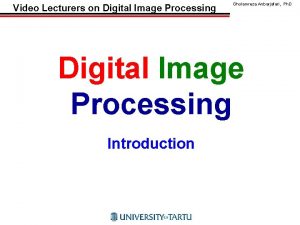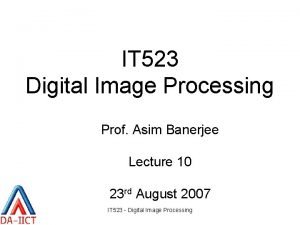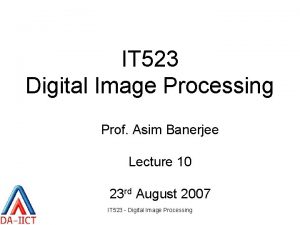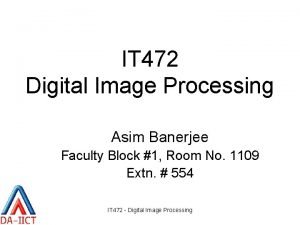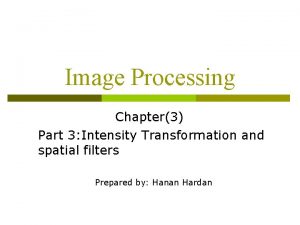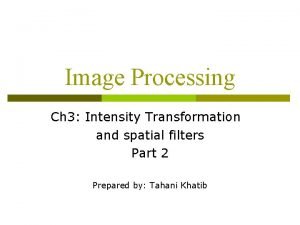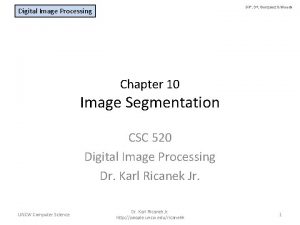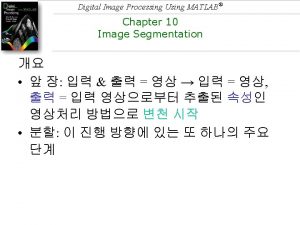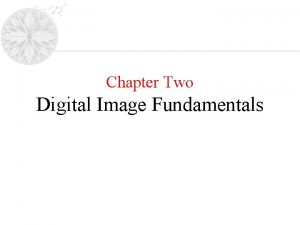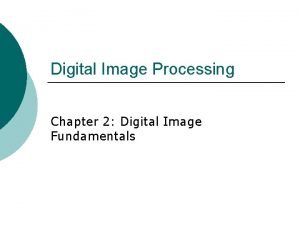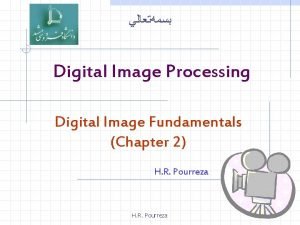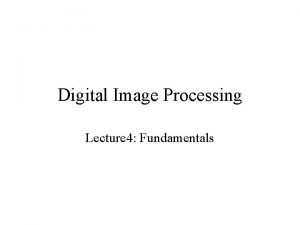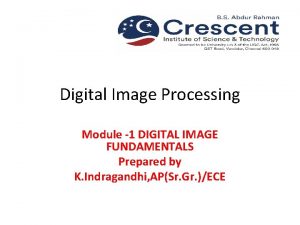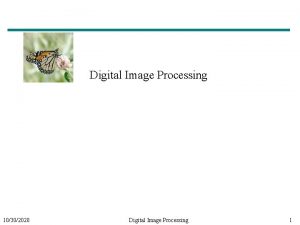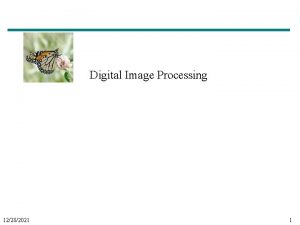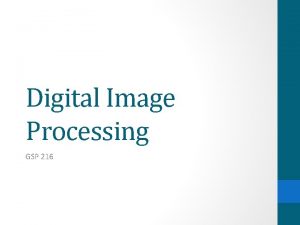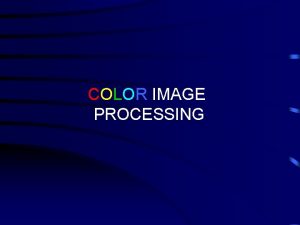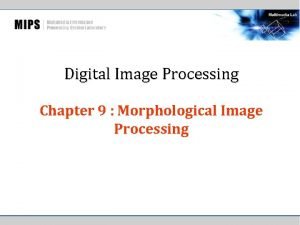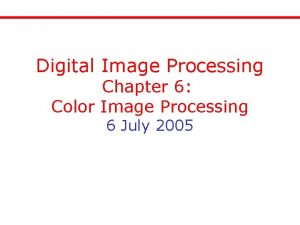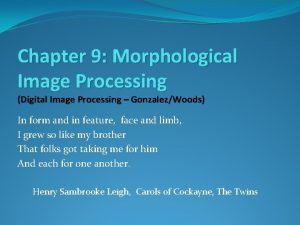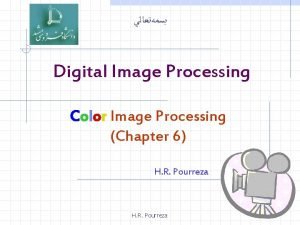Digital Image Processing Chapter 2 Digital Image Fundamentals


























































- Slides: 58

Digital Image Processing Chapter 2: Digital Image Fundamentals

Elements of Visual Perception ¡ Structure of the human eye

¡ Rods and cones in the retina

¡ Image formation in the eye

¡ Brightness adaptation and discrimination

¡ Brightness discrimination

¡ Weber ratio

¡ Perceived brightness

¡ Simultaneous contrast

¡ Optical illusion

Light and the Electromagnetic Spectrum

¡ Wavelength

Image Sensing and Acquisition

¡ Image acquisition using a single sensor

¡ Using sensor strips

¡ A simple image formation model

Illumination and reflectance ¡ Illumination and transmissivity ¡

Image Sampling and Quantization

¡ Sampling and quantization

¡ Representing digital images


¡ Saturation and noise

¡ Number of storage bits

¡ Spatial and gray-level resolution

¡ Subsampled and resampled

¡ Reducing spatial resolution

¡ Varying the number of gray levels

¡ Varying the number of gray levels

¡ N and k in different-details images

¡ Isopreference

¡ Interpolations

¡ Zooming and shrinking

Some Basic Relationships Between Pixels ¡ Neighbors of a pixel l : 4 -neighbors of p , , , : four diagonal neighbors of p , , , : 8 -neighbors of p and

¡ Adjacency l l l : The set of gray-level values used to define adjacency 4 -adjacency: Two pixels p and q with values from V are 4 -adjacency if q is in the set 8 -adjacency: Two pixels p and q with values from V are 8 -adjacency if q is in the set

l m-adjacency (mixed adjacency): Two pixels p and q with values from V are m -adjacency if q is in , or ¡ q is in and the set has no pixels whose values are from V ¡


¡ Subset adjacency l ¡ S 1 and S 2 are adjacent if some pixel in S 1 is adjacent to some pixel in S 2 Path A path from p with coordinates to pixel q with coordinates is a sequence of distinct pixels with coordinates l , , …, where = , and pixels and are adjacent l

¡ Region l ¡ Boundary l ¡ We call R a region of the image if R is a connected set The boundary of a region R is the set of pixels in the region that have one or more neighbors that are not in R Edge l Pixels with derivative values that exceed a preset threshold

¡ Distance measures l Euclidean distance l City-block distance l Chessboard distance

l distance: The shortest m-path between the points

An Introduction to the Mathematical Tools Used in Digital Image Processing ¡ Linear operation l H is said to be a linear operator if, for any two images f and g and any two scalars a and b,

¡ Arithmetic operations l Addition

¡ Arithmetic operations l Subtraction

l Digital subtraction angiography

l Shading correction

¡ Image multiplication

¡ Set operations

¡ Complements

¡ Logical operations

¡ Single-pixel operations

¡ Neighborhood operations

¡ Affine transformations

¡ Inverse mapping

¡ Registration

¡ Vector operations

¡ Image transforms

¡ Fourier transform

¡ Probabilistic methods
 Color fundamentals in digital image processing
Color fundamentals in digital image processing Histogram processing in digital image processing
Histogram processing in digital image processing Point processing operations
Point processing operations Nonlinear image processing
Nonlinear image processing Point processing in image processing
Point processing in image processing Point processing in image enhancement
Point processing in image enhancement Thinning and thickening in image processing example
Thinning and thickening in image processing example Translate
Translate What is image restoration in digital image processing
What is image restoration in digital image processing Compression in digital image processing
Compression in digital image processing Image segmentation in digital image processing
Image segmentation in digital image processing Subjective fidelity criteria in digital image processing
Subjective fidelity criteria in digital image processing Image sharpening in digital image processing
Image sharpening in digital image processing Image geometry in digital image processing
Image geometry in digital image processing Zooming and shrinking in digital image processing
Zooming and shrinking in digital image processing Image transforms in digital image processing
Image transforms in digital image processing Imtransform matlab
Imtransform matlab Image restoration in digital image processing
Image restoration in digital image processing Digital image fundamentals
Digital image fundamentals Digital fundamentals chapter 4
Digital fundamentals chapter 4 Boundary descriptors in digital image processing
Boundary descriptors in digital image processing Representation and description in digital image processing
Representation and description in digital image processing Double thresholding in image processing
Double thresholding in image processing Segmentation in digital image processing
Segmentation in digital image processing Basic relation between pixels
Basic relation between pixels Intensity transformation and spatial filtering
Intensity transformation and spatial filtering For coordinates p(2,3)the 4 neighbors of pixel p are
For coordinates p(2,3)the 4 neighbors of pixel p are Gray level transformation in digital image processing
Gray level transformation in digital image processing Dm distance in image processing
Dm distance in image processing Coordinate conventions in digital image processing
Coordinate conventions in digital image processing Dam construction in image processing
Dam construction in image processing Digital image processing java
Digital image processing java Thresholding in digital image processing
Thresholding in digital image processing Segmentation in digital image processing
Segmentation in digital image processing Digital image processing
Digital image processing Representation and description in digital image processing
Representation and description in digital image processing Thresholding in digital image processing
Thresholding in digital image processing Chain code
Chain code What is color slicing
What is color slicing Intensity transformation in digital image processing
Intensity transformation in digital image processing Intensity transformations and spatial filtering
Intensity transformations and spatial filtering A function
A function Digital image processing
Digital image processing Digital image processing
Digital image processing Haar transform in digital image processing for n=8
Haar transform in digital image processing for n=8 Digital image processing
Digital image processing Jpeg in digital image processing
Jpeg in digital image processing Digital image processing
Digital image processing Mach band effect in digital image processing
Mach band effect in digital image processing Filetype:ppt
Filetype:ppt Digital image processing
Digital image processing Digital image processing
Digital image processing Digital path in image processing
Digital path in image processing Digital path in image processing
Digital path in image processing 472
472 Gray level slicing in image processing
Gray level slicing in image processing Intensity transformation in digital image processing
Intensity transformation in digital image processing Digital image processing
Digital image processing Digital image processing
Digital image processing
